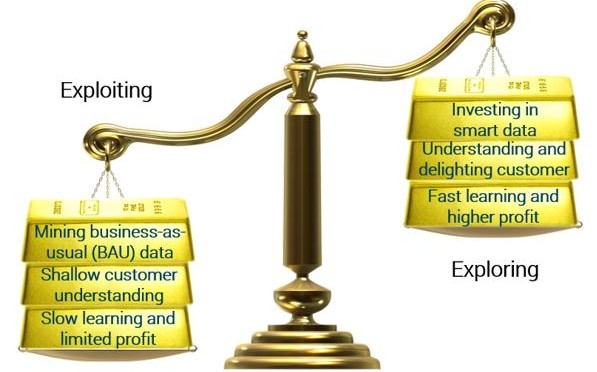Maximizing Customer Value with Sequential Decisions
Blog: Enterprise Decision Management Blog

Leading data-driven businesses increasingly embrace prescriptive analytics – the methods, algorithms and tools that predict and compare likely future outcomes of alternative actions and find the best decisions given business objectives. Typically, these decisions are single-shot decisions and designed to optimize objectives defined over a fixed time horizon — for example, decide on credit limits and interest rates for new accounts to maximize 2-year profit.
An exciting new branch of prescriptive analytics involves stringing together decision sequences over time. With sequential decisions, we decide how to act today using a more strategic approach that balances the near-term profit or cost associated with today’s decision with the future expected value that depends on subsequent decisions. For example for credit cards, subsequent line increase/decrease decisions will be taken that will affect future cashflow, and increases need to be administered carefully because they are hard to reverse. Sequential decisions connect today’s and future decisions.
A sequence of decisions may go over a customer lifecycle. For example, a marketer may decide today to spend $70 in acquisition costs to turn a promising prospect into a customer. If she becomes a customer, then, depending on her first 3 months of shopping behavior, another decision will be taken whether to spend $30 in incentives to entice her into a loyalty program. Sequential decisions take into account transition probabilities between engagement states (for example prospect, new customer, frequent shopper, loyalty member) and their associated profit contributions and marketing investments, across the lifecycle. Sequential decisions can be optimized to maximize Customer Lifetime Value (CLV), whereby near-term investments can be traded off against expected future profits.
Another benefit from connecting sequential decisions can derive from stringing together customer management decisions with informational actions that actively collect new and relevant data about the customer.
In particular, sequential decision analytics helps decide whether to collect new information prior to making a consequential customer management decision. Information-gathering decisions must often trade off expected value of new information against information collection costs.
For example, a credit card marketer needs to decide on retention offers for certain profitable accounts that face high attrition risk. A segmentation of this group based on card transaction data may indicate a presumably highly price-sensitive sub-segment (where low fees may sway them to stay) and a sub-segment with presumably low price sensitivity (where higher rewards may be a better lure). There may also be a sub-segment with behavior patterns showing mixed results.
Sequential decision analytics can trigger individual dialogues with such customers – for example, through a mobile banking app – to confirm their actual preferences prior to extending a retention offer. The benefit for responders is that they receive relevant offers and engagement from their financial institution, and the institution benefits from higher response rates and increased customer value.
We simulated this process to demonstrate how a sequential decision approach can increase customer value even after factoring in dialogue cost and imperfect response. Want to see what we found? Join us at FICO World 2016 in April for the session on “Smarter Data Through Sequential Decisions.”
The post Maximizing Customer Value with Sequential Decisions appeared first on FICO.
Leave a Comment
You must be logged in to post a comment.







